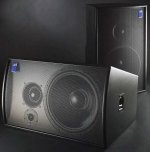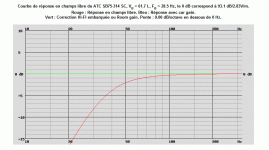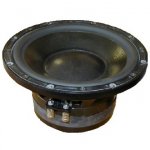Great. Here's another one I'm thinking:
Linkwitz Transform + Seas W26FX001 + CSS LD25X + Dave Pellegrine's custom waveguide for it to extend response down to ~950hz
Thank you for this. I have a bit of prejudice against metal drivers but it's not really based on anything this looks like a very good driver for the job. The tweeter looks (to my untrained eye) like it's very happy above 5k but there's some major dips below that and especially as it gets down towards 1k.
do you have any links relating to this design?
I'm starting to doubt the importance of designing to eliminate the vertical lobing at the crossover. I don't think I like the Vifa NE19VTA-04 tweeter anymore so a larger one with a higher crossover might be the better choice.
With a Linkwitz Transform the woofer produces decent bass in that smallish box but 30Hz will be pushing it. You do need at least a high excursion 10".
thank you. I don't understand the stuff about vertical lobing, but as crossing over low seems to be the way to go an oversized soft dome makes sense to my (limited) understanding.
I do not need to get all the way down to 30. building the box that naturally has the lowest q possible within my space limitations , seeing where that gets me down to and then using the linkwitz transform to extend a little more so as not to increase the power requirements too much is the way I'm looking at it. Does that approach make sense?
designing speakers with a passive crossover and a nice flat response is difficult and depends on many parameters, box design, driver choice, then a perfectly implemented crossover. some drivers just wont work well together, the cabinet might end up to narrow and you have so much baffle step compensation that your amp cant overcome the sensitivity loss.
IMO, for a critical listening application you are better off finding a existing design that has been measured to have the response curve you are looking
for.
It just happens that Troels is one of the few diy designers that works with the highest of high end drivers from scanspeak, seas and accuton.
If i were to pick a design to use as monitors here's what i would use
Illuminator-Monitor
Not saying that desiging on your own is a bad idea its just A LOT of work and learning and making mistakes.
IMO, for a critical listening application you are better off finding a existing design that has been measured to have the response curve you are looking
for.
It just happens that Troels is one of the few diy designers that works with the highest of high end drivers from scanspeak, seas and accuton.
If i were to pick a design to use as monitors here's what i would use
Illuminator-Monitor
Not saying that desiging on your own is a bad idea its just A LOT of work and learning and making mistakes.
I have a bit of prejudice against metal drivers but it's not really based on anything this looks like a very good driver for the job.
IMO metals like magnesium and beryllium, and even aluminum are ideal. The reason for this is also the reason some are biased against them - they are inherently pistonic to a high frequency so resolution is limited by the motor, not the cone. Paper will give a flatter frequency response before the crossover, but much of that can be be incognito controlled breakup (distortion). This is why people say paper sounds smooth - it is very mid fi and forgiving. Paper is still great if used below its breakups, but they are hard to recognize without laser spectrography. Most people will cross paper cones up as much as an octave above its breakup, because the NLD and frequency response are very inviting.
When metal breaks up it is much more obvious in the response graph - it can sound harsh and offensive if unattended. A good designer can electrically hide the metal breakup from audibility (get it about 40+ db below the fundamental), while sqeezing every last bit out of the pistonic range.
The tweeter looks (to my untrained eye) like it's very happy above 5k but there's some major dips below that and especially as it gets down towards 1k.
That's just the natural low q driver rolloff which you can use in your crossover function. either way those measurements are of the driver in a flat baffle - I was recommending the driver in a waveguide where its forward response goes a bit deeper anyways, albeit with a steeper rolloff. The waveguide is very important for mating a 10" driver to any tweeter as it helps match decently the directivity indeces.
do you have any links relating to this design?
I'm on my phone, but the thread on dave pellegrene's ld25X waveguides is on the parts express board. the low pass for the woofer, and getting good phase tracking - is something you'll need some help with.
I want to add that much of this also applies to active crossovers. The same unique shaping of responses and phase needs to be measured and formulated before either type of crossover is built.designing speakers with a passive crossover and a nice flat response is difficult and depends on many parameters, box design, driver choice,
Speakers in general become directional around the same frequency region as their breakup stimulus as both are related to the size of the cone, so there is hardly a proper reason to be using them up that high.Most people will cross paper cones up as much as an octave above its breakup, because the NLD and frequency response are very inviting.
Paper cones are often used into the early breakup region where the directivity is needed at the crossover. Any reputation for mid-fi is incidental.
designing speakers with a passive crossover and a nice flat response is difficult and depends on many parameters, box design, driver choice, then a perfectly implemented crossover. some drivers just wont work well together, the cabinet might end up to narrow and you have so much baffle step compensation that your amp cant overcome the sensitivity loss.
IMO, for a critical listening application you are better off finding a existing design that has been measured to have the response curve you are looking
for.
It just happens that Troels is one of the few diy designers that works with the highest of high end drivers from scanspeak, seas and accuton.
If i were to pick a design to use as monitors here's what i would use
Illuminator-Monitor
Not saying that desiging on your own is a bad idea its just A LOT of work and learning and making mistakes.
Thanks for your advice. Yes this thread has followed the trajectory of many a newbie thread on here due to not quite realisising the complex integral nature of crossover design. This despite doing quite a bit of reading before posting- I should have read newbie threads!
The Troels site is somewhere I keep going back to. Both the illuminator and Quattro seem possibilities. None of the FR graphs go below 200hz though... He says the illuminator has a good bottom end that can be increased further by increasing the cabinet size, and the Quattro has a port tuned to 40-45 hz, so i suppose f3 would be just below that. I have enough space and corner traps behind so rear ported speakers would be ok
I want to add that much of this also applies to active crossovers. The same unique shaping of responses and phase needs to be measured and formulated before either type of crossover is built.
Speakers in general become directional around the same frequency region as their breakup stimulus as both are related to the size of the cone, so there is hardly a proper reason to be using them up that high.
Paper cones are often used into the early breakup region where the directivity is needed at the crossover. Any reputation for mid-fi is incidental.
Thanks, makes sense
so again it's all about the crossover- if it is designed to work to the strengths of the driver and not ask it to do what it's not good at the driver will sound good.
None of the FR graphs go below 200hz though... He says the illuminator has a good bottom end that can be increased further by increasing the cabinet size, and the Quattro has a port tuned to 40-45 hz, so i suppose f3 would be just below that.
I think most of his stuff should reach down to around 35-45 hz which is running up against room size limitations.
if you need lower add a sub or mix the low end with a good set of headphones
I think most of his stuff should reach down to around 35-45 hz which is running up against room size limitations.
if you need lower add a sub or mix the low end with a good set of headphones
I have just sent Mr Gravesen an email asking his advice on which of his designs he thinks is best suited.
I am very anti separate subs for my particular application. It would need to be perfectly designed and installed for the room and speakers...too many potential pitfalls. For me sound has always been most satisfying when it is coming from a single source relative to distance ( a large stack of PA always sounds better to me than a line array at a festival)
If I thought there was a coaxial driver that could do the full range for me in a stand mounted box I would be attracted to that design
I agree with you about subs. But you don't give nice dimensions for a full range size speaker, at least not with LF extension. On another note look at the coax UREIs-813 with Eminence helper.
History and Legacy of JBL - The Second Harman Era (1980 - Present)
???????????? : UREI 813
You can see here that with an ATC LF 375 mm SL you have a mere "Frequency Response (+/-2dB) : 60Hz–12kHz" nothing else (like 30Hz that you r looking for), rethink again. ATC PA65 Live Sound Monitor | ATC SPEAKERS.COM, USA
For extension look at different set ups like this one from Madisound.
Madisound Speaker Store
Eton 11.2 crossover 3-Way
You also have the kits from wilmslow-audio.co.uk
ATC K50 & K100
and you have the classic kit with 3-Way ATC
DIY ATC SCM100s... - Page 2 - pink fish media
Good endeavors in you quest.
History and Legacy of JBL - The Second Harman Era (1980 - Present)
???????????? : UREI 813
You can see here that with an ATC LF 375 mm SL you have a mere "Frequency Response (+/-2dB) : 60Hz–12kHz" nothing else (like 30Hz that you r looking for), rethink again. ATC PA65 Live Sound Monitor | ATC SPEAKERS.COM, USA
For extension look at different set ups like this one from Madisound.
Madisound Speaker Store
Eton 11.2 crossover 3-Way
You also have the kits from wilmslow-audio.co.uk
ATC K50 & K100
and you have the classic kit with 3-Way ATC
DIY ATC SCM100s... - Page 2 - pink fish media
Good endeavors in you quest.
Attachments
Attachments
3-Way Wilmslow-Audio Prestige Loudspeakers with ATC/Volt drivers
Prestige Loudspeakers
Prestige Loudspeakers
I really like the idea of a sealed box using linkwitz transform.
I do not understand why it is not being used more in studio monitors where people definitely want a flat extended LF response.
The extra power requirements? its not an expensive circuit is it?
would it not be a good approach to build a box that has the lowest f3 possible with the most suitable say 10" driver and then use the L Transform minimally to get it down somewhere sensible but not excessive like 38hz, so that the power requirements not pushed up hugely?
I do not understand why it is not being used more in studio monitors where people definitely want a flat extended LF response.
The extra power requirements? its not an expensive circuit is it?
would it not be a good approach to build a box that has the lowest f3 possible with the most suitable say 10" driver and then use the L Transform minimally to get it down somewhere sensible but not excessive like 38hz, so that the power requirements not pushed up hugely?
would it not be a good approach to build a box that has the lowest f3 possible
No, not necessarily. You won't likely achieve a flat response due to the various resonances/cancellations which are room modes. Meanwhile you have made sacrifices to your design to achieve the low f3, eg: efficiency, power handling.
No, not necessarily. You won't likely achieve a flat response due to the various resonances/cancellations which are room modes. Meanwhile you have made sacrifices to your design to achieve the low f3, eg: efficiency, power handling.
Thanks Allen
Ok so not the lowest f3 possible then, but through careful driver choice and the largest box that didn't sacrifice too much, get the f3 low enough that the Linkwitz transform could be used sparingly?
and perhaps using an oversized dome tweeter to get the crossover point below 1500 would help with mid-bass driver choice
I know many before me have been down this path and been told to use an existing design, but I cannot find anything that fits (and once the idea is refined I will get expert assistance).
the idea has evolved from the original post:
accurate monitor for nearfield (1.25M)
2 way, sealed box up to 40l. f3 below 40hz
I have been reading up, and trying to find drivers with the best characteristics for this design, but don't understand enough. I'd like to get as much sorted as possible before I get my friend involved- anyone want to weigh in with drivers suitable for a sealed box, long xmax, high power handling and all the other stuff I don't understand yet. Volt looked good, but apparently don't like sealed boxes
My point was more on whether I'd choose to stretch a main speaker as low as possible, in your position it may not be a bad idea. If you want a low f3, look at Qtc=0.7. A driver that others have successfully used in a dipole may make a good Linkwitz transform driver. When it comes to the bass, I don't think that needing an existing design is the point, there are other troubles regardless.
My point was more on whether I'd choose to stretch a main speaker as low as possible, in your position it may not be a bad idea. If you want a low f3, look at Qtc=0.7. A driver that others have successfully used in a dipole may make a good Linkwitz transform driver. When it comes to the bass, I don't think that needing an existing design is the point, there are other troubles regardless.
Thanks Allen. Yes Plenty troubles...spoke to my genius friend and he's into the idea but it would have to be active which means more amps

and he's super busy over the summer so it's hanging in the balance
This sub is interesting, can be used 1 per side. There are more variants (drivers), this is just one of them.
HiVi SP10 Sub-Woofer
It can integrate a 2 way easily, passive or active. In a small 32 L (BR) can go low to F3=24Hz. Also good for a quarter wave.
Jensen-1071
The SS 26W8861T00 woofer can do F3=28Hz in a 103L enclosure (BR) or F3=31Hz in a 75L (BR).
A variant, good for sealed is the SCANSPEAK 26W8534G00 in a VB = 105.0 L, F3=31 Hz (alu cone).
Use the EBP CALCULATOR.
There are thousands of iterations... Have fun.
HiVi SP10 Sub-Woofer
It can integrate a 2 way easily, passive or active. In a small 32 L (BR) can go low to F3=24Hz. Also good for a quarter wave.
Also, as an example, if doing another design with Scanspeak as is this 3-WayIf i were to pick a design to use as monitors here's what i would use
Illuminator-Monitor
Not saying that desiging on your own is a bad idea its just A LOT of work and learning and making mistakes.
Jensen-1071
The SS 26W8861T00 woofer can do F3=28Hz in a 103L enclosure (BR) or F3=31Hz in a 75L (BR).
A variant, good for sealed is the SCANSPEAK 26W8534G00 in a VB = 105.0 L, F3=31 Hz (alu cone).
Use the EBP CALCULATOR.
There are thousands of iterations... Have fun.
Attachments
-
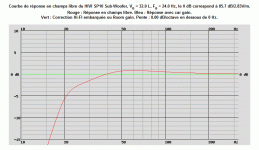 HIVI SP10 Sub-Woofer, VB = 32.0 L, FB = 24.0 Hz, 85.7 dB2.83Vm. F3=24 Hz, F6=20 Hz, F12=17 Hz 06.gif15.8 KB · Views: 127
HIVI SP10 Sub-Woofer, VB = 32.0 L, FB = 24.0 Hz, 85.7 dB2.83Vm. F3=24 Hz, F6=20 Hz, F12=17 Hz 06.gif15.8 KB · Views: 127 -
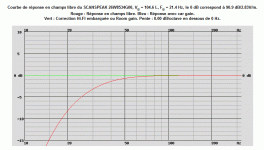 SCANSPEAK 26W8534G00, VB = 104.6 L, FB = 21.4 Hz, 90.9 dB2.83Vm. F3=31 Hz, F6=23 Hz, F12=17 Hz 0.gif16 KB · Views: 125
SCANSPEAK 26W8534G00, VB = 104.6 L, FB = 21.4 Hz, 90.9 dB2.83Vm. F3=31 Hz, F6=23 Hz, F12=17 Hz 0.gif16 KB · Views: 125 -
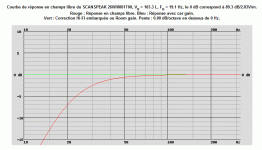 SCANSPEAK 26W8861T00, VB = 103.3 L, FB = 19.1 Hz, 89.3 dB2.83Vm. F3=28 Hz, F6=22 Hz, F12=16 Hz 0.gif15.9 KB · Views: 118
SCANSPEAK 26W8861T00, VB = 103.3 L, FB = 19.1 Hz, 89.3 dB2.83Vm. F3=28 Hz, F6=22 Hz, F12=16 Hz 0.gif15.9 KB · Views: 118
Last edited:
I was thinking of something (my design), what's your feedback/impressions...
Well there are drivers that work in big boxes >75/100 L and drivers that work in small boxes ~50 L or smaller. Guess what... speak to your genius friend more and start taking note of the drivers you will need.
One of the best drivers in the world:
ETON 11-58150 HEX, VB = 58.3 L, FB = 22.6 Hz, 90.0 dB2.83Vm.
F3=34 Hz, F6=26 Hz, F12=19 Hz [04.2012]
Cabinet plans here
Crossover design here
Madisound Speaker Store
Well there are drivers that work in big boxes >75/100 L and drivers that work in small boxes ~50 L or smaller. Guess what... speak to your genius friend more and start taking note of the drivers you will need.
One of the best drivers in the world:
ETON 11-58150 HEX, VB = 58.3 L, FB = 22.6 Hz, 90.0 dB2.83Vm.
F3=34 Hz, F6=26 Hz, F12=19 Hz [04.2012]
Cabinet plans here
Crossover design here
Madisound Speaker Store
- Status
- This old topic is closed. If you want to reopen this topic, contact a moderator using the "Report Post" button.
- Home
- Loudspeakers
- Multi-Way
- top spec nearfield monitor with extended LF response
